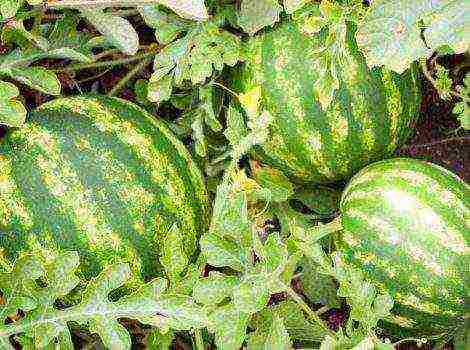Content

A home pond is the best decoration for a summer cottage or garden. And various plants are the decoration of the pond itself. The most common flowering plants in the pond are water lilies (nymphea) or water lilies. They are unpretentious in care and will delight the eyes of the hosts and their guests all summer long.
You can grow such flowers from shoots or seeds. The first option is suitable for those who want to see the blossoming buds as soon as possible. The second option requires patience. And if you are patient, and caring for the plant brings you pleasure, then this article is for you.
- Growing from seeds
- Preparing a plant for wintering
- Varieties of water lilies (nymphs)
- Attraction
- Moorei
- Hermine
- Indiana
- Mayla
- Gonnere and Almost Black
- Aurora
- Arc-en-ciel
- Joey tomocik
Growing from seeds
Water lily seeds are similar in appearance to coffee beans, but they are somewhat larger in size. Check the seeds for damage before planting. Only a whole and unexpired seed will turn into a plant. As for the shelf life, the nymphaean seed can be stored for up to 5 years. For germination, it is enough to place the seeds in a transparent container with settled water, pouring a two centimeter layer of sand on the bottom. The sand should cover them. Use soft water, preferably not from the mains, hard or salt water, it causes irreparable harm to the plant that has not yet matured. Place your container in a warm and well-lit place.
Subject to all these rules, you will be able to observe the first leaves in 5-7 days. Water lily leaves should always be on the surface of the water. Therefore, when your flower grows up, move it to a deeper container. If you have several seedlings, then each should have its own dishes.
The best time to move plants to a permanent reservoir is the end of May. How to plant (plant) a water lily (nymphea) in a pond: Buy soil for aquatic plants, plant each flower in a separate container and place it at the bottom of the pond. A pond or other body of water in which this beauty will live must be under the sun, otherwise you will not wait for flowers. The first buds will appear only in the third year. Therefore, please be patient.
Preparing a plant for wintering
A water lily cannot hibernate in shallow water bodies outside, this is true for all cases when freezing reaches the bottom.
Let's figure out a little how to prepare a nymphea for winter. The best place for wintering may be the basement. Storing the nymphea in the basement: just take out the container in which the rhizomes are located and transfer it to the basement, or another dark, cool, but frost-proof place. If you are sure that your reservoir will not freeze to the bottom, then the water lilies can be left to winter in place. This applies to reservoirs with a depth of 0.5 m.
As you understand - water lilies, it is quite easy to grow at home. Create favorable conditions for them and admire the beautiful flowers.
Varieties of water lilies (nymphs)
Let's consider some types (varieties) of nymphs in more detail:
Attraction

One of the largest lilies, it is also popularly called the nymphea "attraction", although translated from English it will be "attractive or lovely". Suitable for deep reservoirs (they say that it grows successfully even from a depth of 4 meters), and 1.5 meters "just seeds", leaving several meters to the sides, the bush will grow successfully. The rhizome is large, it takes root without difficulty. It is very similar to the Conqueror, only the flowers are larger, the tips of the petals are sharper, the color is darker (you can practically distinguish it if both species grow side by side). The leaves are dark red at the beginning, then turn green. The photo clearly shows that this pink water lily is large and has whitish petals at the edges with a bright yellow center.
Nymphaea Attraction blooms for 5-6 days, closer to autumn, individual flowers can bloom for up to 10 days or longer, but after 5 days they stop closing at night.Flowering begins later than the early varieties of lilies, but ends up blooming, in fact, the last. Some buds are left to winter under the ice. It is very rare, but still you can see that the overwintered flower bloomed in the spring. True, it will be much smaller than those that bloom in summer, white and not fully revealed.
Summing up, large, undemanding, quickly spreading, a real "attraction", sometimes it can pleasantly surprise with its deviations, such as prolonged flowering, and the flowering of last year's flowers in spring.
Moorei

This species can be planted in mid-summer, even in bloom. It will take root without problems, although it will not bloom again in the same year. Next year it will delight you with beautiful flowers, although not too abundant. If it weren't for the very pleasant yellow hue that enlivens the view of the pond, this lily would be rather dull. Dull lines of petals, light yellow (you can see this in the photo), flowers are smaller than the water lilies we described earlier.
It blooms more moderately than Conqueror, Rossenymphe or even Colorado. At the same time, more than 4 flowers from a bush are rare. Blooms for 4 days, fairly stable.
However, this lily has very beautiful large burgundy mottled leaves. Even without flowers, Moorei looks very decorative. The bush itself is quite compact, not prone to overgrowth, the leaves grow in tightly knit groups.
Feels better at a depth of one meter, adapts to water fluctuations. As the water level rises (after rain), the flowers open up under water. True, then they become almost white and do not fully bloom, wither after three days. But the sight of a flower that has opened under water is no less decorative.
Winters well. Spring awakens one of the last, early begins to prepare for winter, stops blooming. Looks very nice in small ponds.
Hermine
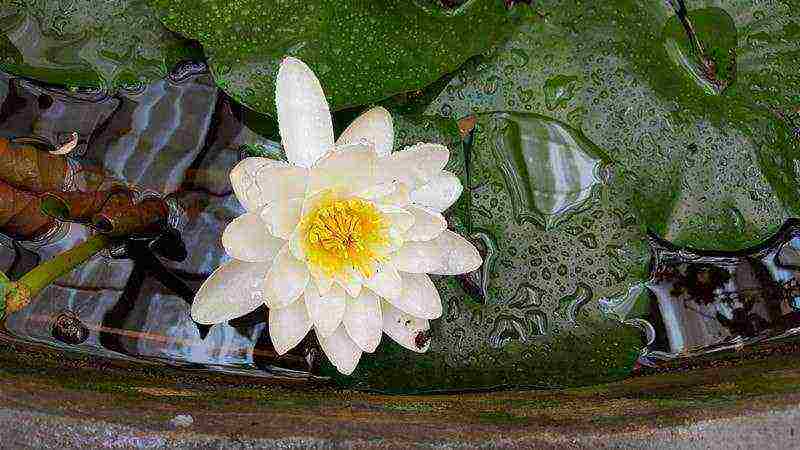
A dwarf nymphea, like two drops of water, similar to an ordinary white lily, only much smaller. The leaves are green, flawless white petals, bright yellow stamens and stigma of the pistil. There are few leaves, the bush is not very exuberant.
In the first year, flowering is weak (2-3 flowers). Flowering begins closer to mid-summer. If the summer is hot, it blooms for only 3 days, although many online stores describe them as lilies of long flowering, which can be grown in a tub, font, especially in combination with Pygmaea Rubra. Maybe this is true, most likely, a not so hot summer is needed for long flowering. And although this water lily is dwarf, but still this purely white plant is intended, first of all, for shallow water bodies, and only a bottom for tubs, in which you can also grow on the balcony.
Indiana
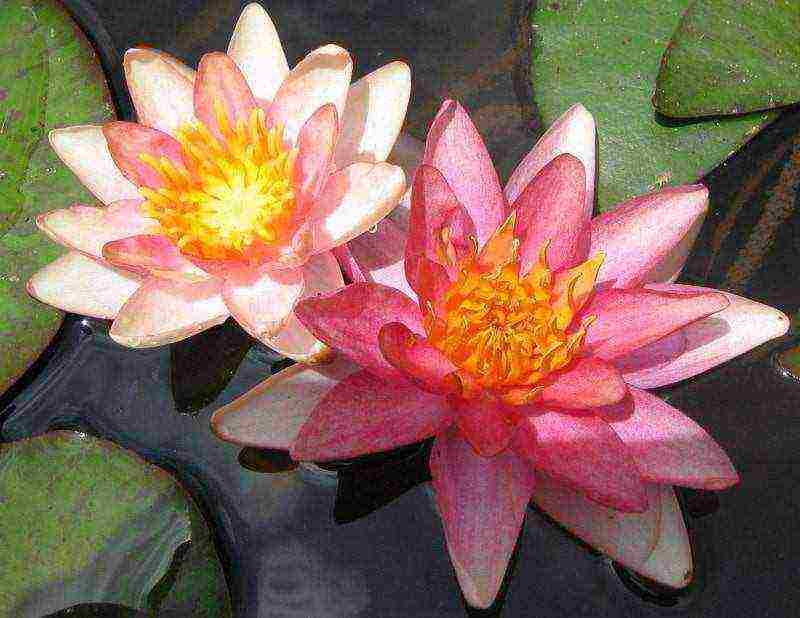
The type of lilies of medium size, probably more to small. The bush is small, rare, few leaves. The optimum depth is about 60 cm (but not more than 90 cm). The leaves initially have a burgundy color, subsequently change color to green. Blooms for about 5 days. The flowers are medium. Unlike Rossenymphe, whose flowers simply fade, Indiana changes color. The spotting of the petals increases.
What can be said about the beginning and end of flowering - the variety is not one that begins to bloom early, but begins to prepare for wintering earlier than other sisters.
Although this water lily looks very attractive, especially at its peak flowering, it should not be planted next to other lilies, especially bright flowers. Next to large-flowered ones, it will simply disappear, creating not too attractive variegation. After all, Indiana itself has several color variations, and if other flowers bloom nearby. However, it is ideal for small (1-3m in diameter) pools.
Mayla
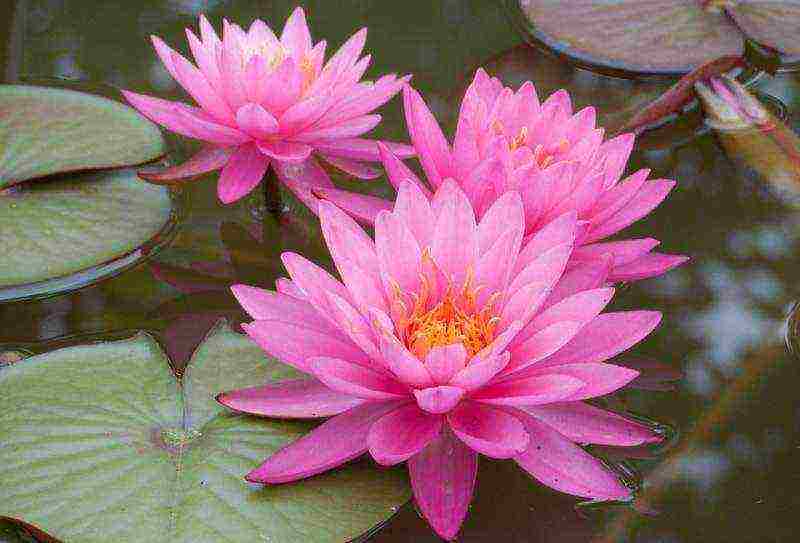
They bloom for the first time in the second year after planting. The nymphaea "mayla" is slightly larger than average. The leaves of this water lily are large, green, but at the beginning the leaf has a burgundy hue. The bush is not very lush and multi-leaved.
Fuchsia flowers, double, even "very double". Having seen her for the first time, it is even difficult to believe that this is a living flower, so this water lily is “poisonous” pink, you can clearly see it in the photo.It looks fake.
This species is a little more whimsical than the varieties described above. This lily needs a sunny place (does not even like partial shade), well-warming water. It cannot boast of abundant flowering - it blooms for only 4 days. But the unusual color compensates for all the disadvantages of this type.
Gonnere and Almost Black
You can choose water lilies by size, color, smell, or you can try to create compositions by contrast. For example, by planting these two species side by side: Almost Black and Gonnere. Both of these lilies are medium in size, can be attributed to "spoiled", do not smell, but the flowers are "double double".
The size of the flower begins to "feel" as soon as the buds come out of the water. They are much larger than others.
The leaves of both varieties are green, young with a slightly burgundy hue, which can remain a little longer at the edges of the leaves. The bushes of these lilies can be combined into one by planting them next to each other.
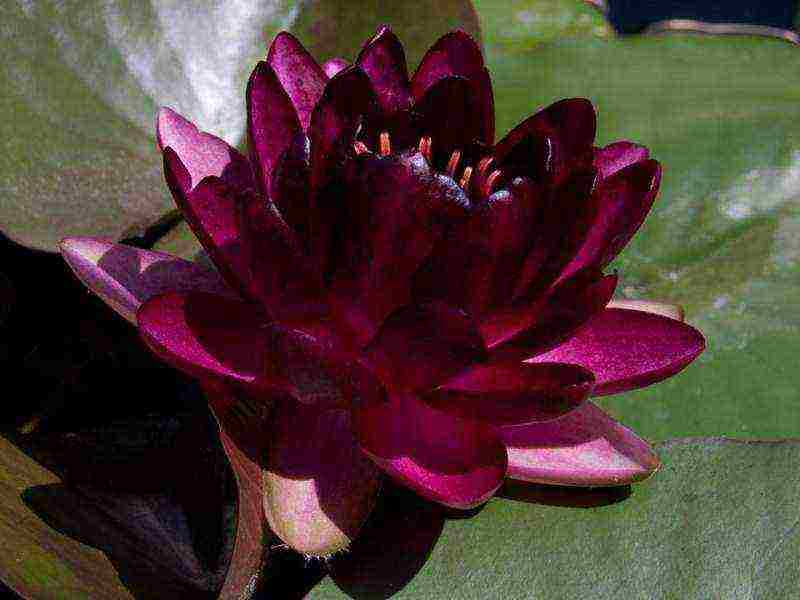
The flowers of the lily of the Almost Black variety are maroon. The tops of the petals are obtuse, resembling a peony flower. It is one of the darkest water lilies in Europe, and perhaps the darkest of the bred frost-resistant varieties.

Gonnere has a snow-white water lily, quite fragrant, these two varieties of water lilies are not wild plants and are perfect for backyard ponds (they will not give "wilds"). The flower is like a ball of white snow - so snow-white. The tops of the petals, like color, the opposite of Almost Black, are sharp.
Both of these water lilies do not bloom as abundantly as the popular and common varieties. The first flowering will also have to wait. For example, you can wait two years for the first colors of Almost Black.
The beginning of flowering is also later. When growing these two species, you need to take care of root nutrition. If there are no nutrients in the soil, additional fertilization is needed, since both species "spend a lot of energy" during flowering.
As already mentioned, these two types can be combined according to the principle of contrast, but since they mature after two or three years, you will have to arm yourself with patience until the "black and white" becomes pronounced on the surface of your pond.
Aurora
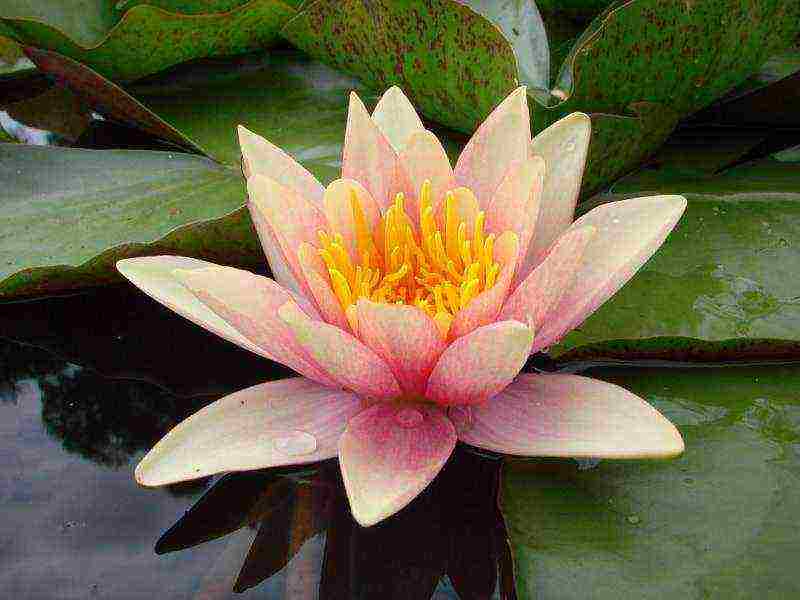
If your body of water is very tiny, only a few meters, or you just want to try growing a nymph in a tub (barrel) on the balcony, try this type and you will grow your own water lily at home. Due to its small size, it is suitable for growing in small containers.
The cultivar is not a subspecies of nymphs, the dwarf cultivars Nymphaea pygmaea. rather, it is a hybrid of Nymphaea odorata. But in size, she really is a dwarf.
The green leaves are slightly larger, maroon at first, but the flowers are very similar to Pygmaea Rubra. The only difference is that the nymphea "aurora" has one more petals, the flower looks more double, it also has an orange tint. Blooms 3-5 days, more abundant than other dwarf lilies, flowering also begins earlier than others.
Arc-en-ciel
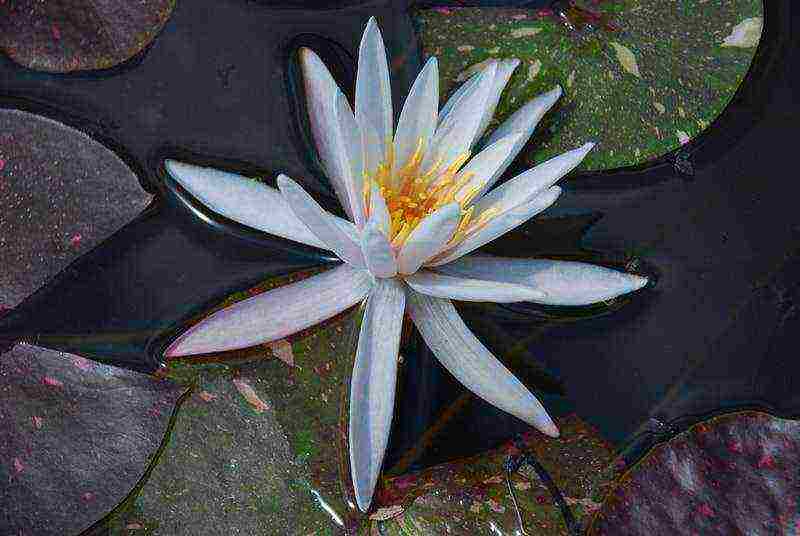
This lily can be classified as large and more whimsical. The depth should be selected in the range from 1 to 1.5 m, leaving about the same amount of space on the sides. Having planted too shallow, the leaves "scatter" to the sides, and the center of the bush remains empty.
The flowers are white with a pink tint, bright yellow in the middle. The flowers of adult bushes rise 10-15 cm above the surface of the water, the petals tilt back, and the lily itself becomes like a lotus. Very few varieties of winter-hardy water lilies are distinguished by this shape of flowers. The flowers of young bushes float on the surface of the water, standing out only in that the petals are sharper.
Another distinctive feature of this species, not typical for most lilies, is very variegated, large leaves. At first they have a bright burgundy hue, then turn green, but all the time they remain with cream, pink, burgundy stripes or spots. Even without flowers, lilies of this species are much more beautiful and decorative than other varieties.
That kind of whims, you can see right away.The first is that it begins to grow only when the water in the pond warms up well, much later than other types of lilies. Most likely, not one of the last, but the last. She is preparing for winter, she is also one of the first to start.
Joey tomocik
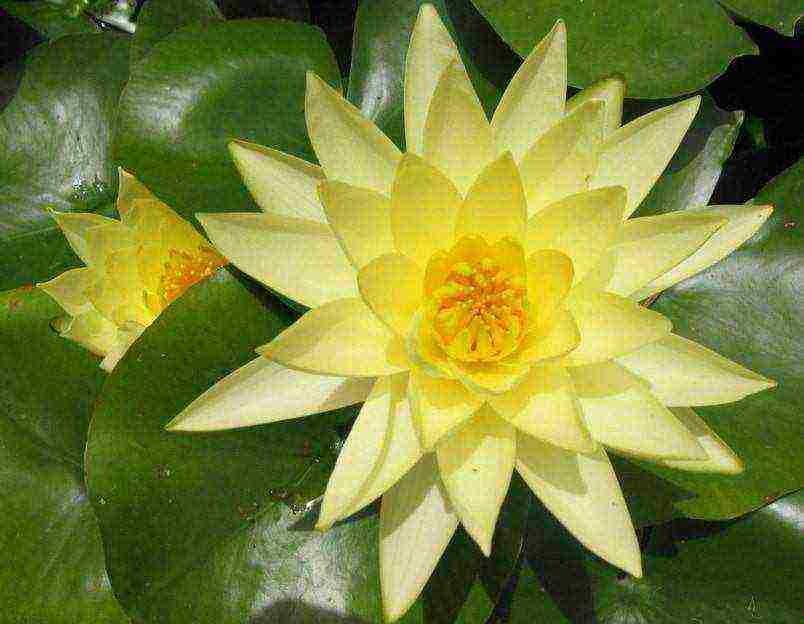
It was not possible to obtain any original information about this species, but if you ask lily breeders what they can advise in the first place, 9 out of 10 will answer - Joey Tomocik.
This species is derived from the American wild, especially prolific and resistant to adverse conditions, abundantly flowering yellow lily Nymphaea mexicana. Flowers of the wild "mother" of this species, if a little paler, but not inferior in size. After all the selection and crossing of Joe Tomocik, Joey Tomocik (the lily is named after him) managed to breed a frost-resistant species with brighter flowers, which quickly spread throughout the world.
By the way, this type of lily also reproduces by seeds, therefore, if the summer is very warm, there is a danger that it will spread throughout the reservoir with its less decorative offspring that deviate from the standard of the mother plant or that appeared from crossing with other plants of the reservoir.
In conclusion, we advise you to watch the video on caring for the nymphs.
Nymphaea, water lily, water lily, mermaid flower - a perennial growing in reservoirs where there is no strong current, in the backwaters of slow rivers, and more recently in mini-ponds that adorn summer cottages. Planting a delicate water lily is not difficult for a nymph, she needs minimal care if you create suitable conditions for a mermaid flower.
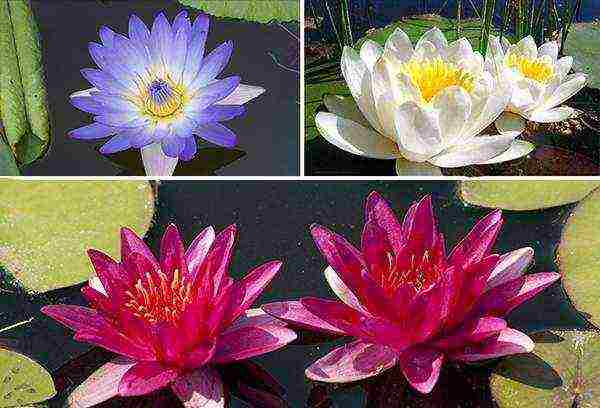
How to choose a nymph for planting?
Numerous varieties of nymphea, suitable for growing in artificial reservoirs, are conventionally divided into three groups according to plant size.
- Dwarf, or miniature. The diameter of the flowers is from 3 to 15 cm, suitable for ponds with a depth of 15 cm to half a meter. The color of the flowers depends on the variety - white, red, yellow.
- Average. The flower is up to 18 cm in size, planted to a depth of 60 cm. The flowers are pink, red, yellow.
- Large, with a flower diameter of up to 25 cm. For such nymphs, the optimal depth of the reservoir is not less than a meter. Most varieties have yellow and crimson flowers.
All groups include both exotic, thermophilic and winter-hardy varieties. The following types of winter-hardy water lilies are popular among gardeners in Russia.
- Nymphaea tetragona - tetrahedral water lily, or small. White, rarely pink flowers of small sizes bloom by noon and remain open until evening. Great for decorating mini ponds. The main difficulty in growing is that it is difficult to divide the rhizome, which often forms lateral processes.
- N. candida (white water lily), characterized by high frost resistance. It is characterized by a slowly growing horizontal rhizome. No less popular is her charming relative, the Swedish red nymphea, who loves cold water and lots of sunlight.
- N. odorata, a fragrant water lily, tolerates frosts down to -30 ° C without problems. It has several subspecies, differing in the size and color of the inflorescences. The rhizome has strong lateral roots.
- Nympheae tuberos (knobby nymphea) is the progenitor of a significant number of varieties and hybrids. The main advantage is that the rhizome is easily divided.
The following hybrids are suitable for growing in temperate latitudes.
- Mayla, blooming profusely in August. The pink inflorescence of 18 cm is shaped like a star. Rhizome growth is slow.
- Vanvis is an unpretentious, abundantly flowering variety. Pink petals with longitudinal yellow stripes. No less decorative to pour - with marble veins. The size of the inflorescence is about 20 cm, the planting depth is 60-100 cm.
- Snowflake (snowflake), similar to an aster due to the narrow long white petals. Abundant flowering begins in the second half of summer. tolerates severe winters well.
- Violicious is a rare species, purple or blue in color. Able to survive the winter under a layer of ice after 2-3 years of acclimatization.
When choosing a water lily for planting, first of all, the conditions of the reservoir are taken into account, and then the climatic conditions, because even heat-loving exotics find it easy to arrange a safe wintering place.
Planting a nymphea
The best option is to purchase a ready-made plant placed in a pot at the garden center. Growing from seeds is complicated not so much by the laboriousness of the process as by the need for special conditions for their germination.
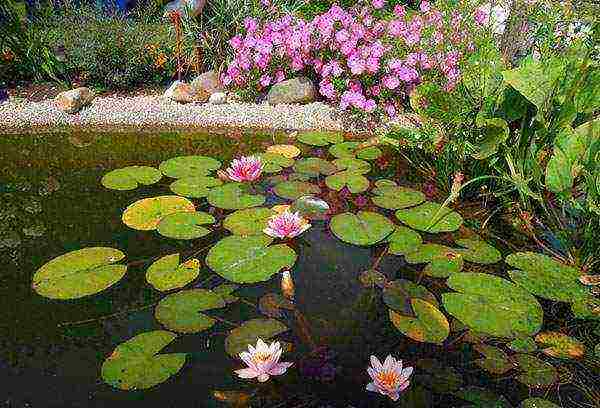
Place in the pond and water
All nymphs are lovers of sunlight, light partial shade during hot hours is permissible.
The reservoir can be filled with tap water. Fortunately, the nymphs do not particularly find fault with the quality and composition of the water.
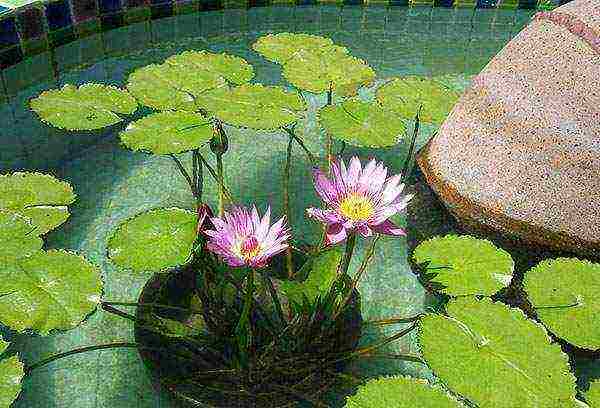
Pot and soil selection
For planting nymphs choose plastic pots, the diameter of which is greater than the height. This point is important to take into account, since the rhizomes of water lilies grow in width, and not in height. In this case, it is not at all necessary that the planter be solid, even a large number of small holes is not an obstacle.
Too large a container will not work for a simple reason: from time to time it has to be removed from the water, that is, taking into account the weight of the soil and water, it must be lifting. Too small pots will affect the size of the flowers: a small rhizome - medium-sized inflorescences.
The soil for planting needs highly fertile, oily, clayey, it is less washed out by water. In preparation for planting lilies, the soil is mixed with organic fertilizers - humus or vermicompost. The standard proportion of soil and organic matter is 7: 3.
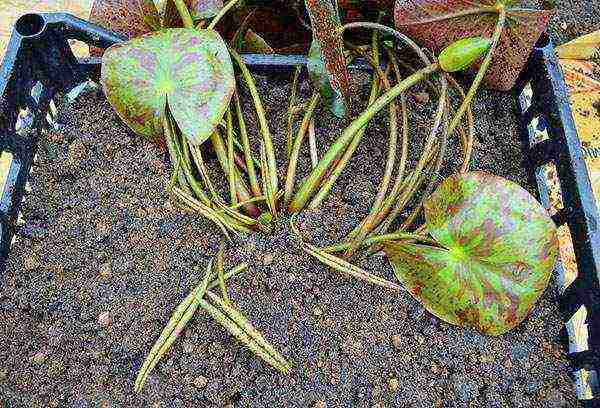
Landing algorithm
The process of planting a nymphea seedling is simple. The container is filled with soil, not reaching the edges of 3-4 cm. A hole is made in the center and the rhizome is lowered there, covered with soil. If there are remnants of "native" soil on the seedling, they are not washed off.
A 2-3-centimeter layer of sand is poured over the soil, which will protect the substrate from washing out. If the pond is inhabited by fish or is often visited by frogs, a layer of pebbles is laid on top of the sand.
The larger the rhizome of the water lily, the greater the depth of its planting should be. In this case, it is imperative that the leaves remain on the surface of the water.
If the pond in the area is deep (more than a meter), you can plant water lilies directly in the bottom soil. Wire staples and stones are used to anchor the root.
Placing a pot with a water lily in the reservoir is carried out in stages.
- At the first stage, the pot is placed at a depth corresponding to the height of the pot plus 10-20 cm using large stones or coasters.
- As the leaves grow back, the container is moved to a greater depth.
- When the foliage grows so much that the pots sink to the bottom, ground nymphs are planted.
Most varieties and hybrids of nymphea completely take root in a few weeks and begin to actively bloom in due time.
Ponds with fountains are not suitable for growing nymphs. The splashes falling on the leaves overlap the stomata located on the upper side of the leaves, the plant begins to suffocate, the leaves rot.
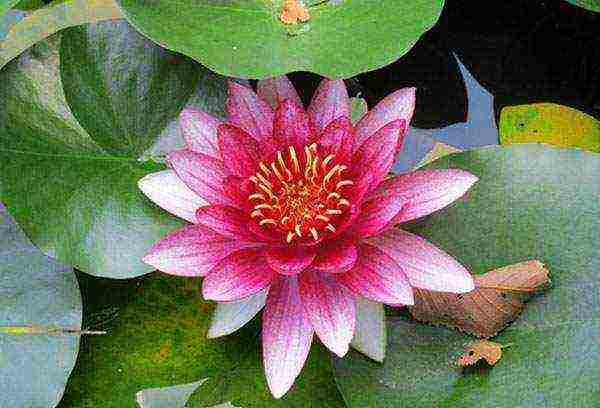
Taking care of the nymphea in the pond
A very pleasant fact for every summer resident: caring for a nymph is minimal. Indeed, she does not need watering, she does not need to weed out the weeds, she also does not need to loosen the soil. The entire care consists of thinning the shoots and removing old, wilting leaves and faded flowers.
All the nutrients necessary for the nymphs for full development are laid in the substrate during planting (transplanting).
Most often, bone meal is used for fertilization. But experts do not recommend using it or any other organic matter, since it provokes the development of decay processes in the reservoir.
The best feeding option is prolonged-release fertilizers that slowly dissolve in water. They are added directly during the preparation of the soil. Special fertilizers for water lilies (rarely on sale): Osmocote; Basacote; Plantella (prolonged action); Ava (long-acting).
Using them in accordance with the instructions provides the plant with nutrients for 2-3 years.
An alternative option is to use flower fertilizer sticks, they are buried next to the roots. Complexes with a high potassium content are chosen, because they provide long-lasting flowering and rich color of inflorescences. Water lilies are fed with sticks once a year - in the spring.
Top dressing is not necessary if the pond is in a natural area, since bottom sludge is the most suitable fertilizer.
Wintering water lilies
Water lilies are sent from the reservoir to the premises for wintering in three cases:
- tropical specimens are grown that love warmer water;
- rare species, which in case of failure it is a pity to lose;
- the depth of the pond is less than 80 cm.
They remove containers from the water long before the onset of cold weather - nymphs, especially tropical ones, love a warm environment. In mini-ponds, the water cools down very quickly, therefore, in temperate latitudes, the nymphea is removed for wintering in the second half of September, in the south - in October. But in the fertile conditions of the Black Sea coast of the Krasnodar Territory and in the south of the Crimea, nymphs winter calmly even in shallow ponds.
It is easy to organize wintering of plants: they are placed in a bucket of water or covered with moist moss roots, packed in a bag and kept in a cool basement. For tropical species, aquariums are used where the water temperature is maintained at 10 ° C and supplementary lighting is organized.

Transfer
Transplant to nymphs growing in pots. As the rhizome grows, the volume of the container becomes small for it, as a result, the leaves and flowers of the water lily become smaller.
Container lilies are transplanted every 2-3 years. The process is not difficult - the container is taken out of the reservoir, the rhizome is removed. Further, it can be transplanted entirely by taking a larger container and transferring it along with an earthen lump. Or you can divide it: pieces with 2 or more kidneys are cut off with a sharp disinfected tool, the delenki are seated in separate containers.
Dividing the rhizome is the easiest and most effective way to propagate a mermaid flower.
A novice gardener can also plant a water lily on his site. She does not require special attention to herself - from the point of view of care, of course, because you can endlessly admire the delicate beautiful flowers.
The Nymphae family.
Name: The water lily got its Latin name from the name of the water nymph. The Slavs called her “mermaid flower” or overpower-grass. It was believed that a water lily flower is able to protect a person during travel from various troubles and misfortunes. There was even a belief “Whoever finds the overpowering grass, that velmy will find talent ... on the way, wherever he goes, he will find a lot of good and overcome evil power and ailments.” It was recommended to put it in an amulet and wear it as an amulet.
Description: The genus includes almost 35 plant species growing in temperate and tropical regions - from the equator to Canada. Specifically, I will focus on one that is found in natural reservoirs in Russia - Snow-white water lily - (N. candida) In the ground, at the bottom of the reservoir, it develops a powerful rhizome with a tuberous surface, reaching 5 cm thick.
 Water lily is snow-white, or pure white, or snow-white (Nymphaea candida)
Water lily is snow-white, or pure white, or snow-white (Nymphaea candida)
Long white cordlike roots extend downward from the rhizome, and wide, rounded in outline, with deep cuts at the base, leaves on long flexible petioles and peduncles rise up to the surface of the reservoir. The blooming of water lilies begins in May-June and sometimes continues until the first frost. Flowering peaks in July-August. The flowers are snow-white with a delicate aroma, reaching 10-15 cm. Outside they have four green sepals, inside white petals arranged in several rows, passing in the center to the stamen. The flower lasts about four days. After flowering, the peduncle twists and goes under the water. Fruit: capsule, develops under water, ripens open and pours out seeds, dressed with mucus, resembling fish eggs.they swim for a while, when the mucus breaks down, sink to the bottom and germinate.
Features of a water lily: in the morning the bud floats to the surface and opens, in the evening the flower closes and sinks to the bottom.
 Water lily is snow-white, or pure white, or snow-white (Nymphaea candida)
Water lily is snow-white, or pure white, or snow-white (Nymphaea candida)
In the garden, ornamental ponds, they grow mainly a hybrid water lily. For small and medium-sized reservoirs, pink water lilies are best suited, they are more hardy and do not grow much.
Location: water lilies prefer a sunny location. They will not bloom in full shade. Planting water lilies should be done at the rate: 1 per 0.5-4 sq. m. otherwise the reservoir will seem overgrown. He loves stagnant water, so it is not recommended to arrange fountains.
Boarding and transfer: The best time to acquire and plant is from early May to late June. Plants can be planted in the ground of a reservoir, but our own experience shows that it is best to plant a water lily in a plastic container of at least 5 liters. (it will be more convenient to clean for the winter). For planting, use: peat 2-3 cm thick at the bottom of the vessel, the mixture is old compost + sand + garden soil, all in equal parts. I used commercially available aquatic plant primer. When planting a water lily, we place fertilizer balls under the roots (meat - bone meal + clay, a ball the size of a tennis ball is made). When planting, do not deepen the growth bud! We crush the soil, cover it with pebbles so that the plant does not float up. Carefully place the pot with the planted plant in the pond. The optimum tank depth depends on the plant variety. Dwarf enough 15-20 cm, very tall 70-100 cm from the growth bud to the surface. In spring, in order to accelerate the growth and development of the plant, the container is placed in shallow water until there are no leaves, after the leaves grow back to the recommended depth. Plants, planted early, have time to take root and bloom in the first year of life in a new place.
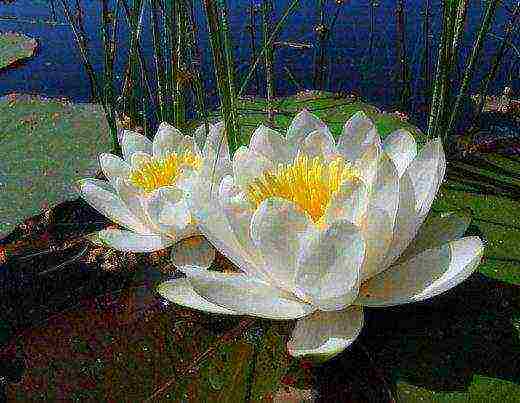 Snow-white water lily
Snow-white water lily
Wintering: The most difficult thing in growing water lilies is keeping them in the winter. This problem has to be solved individually. Plants can remain in their places in winter if they are at a depth of 0.5 m or more, and the reservoir is large and does not freeze to the bottom. If the reservoir can freeze to the bottom or the water is drained for the winter, then the containers with water lilies should be moved to a cool, dark, non-freezing place. Water lilies wake up in the spring when the water starts to warm up. At this time, the plant that hibernated outside the reservoir must be returned to its place. If there is not a lot of melt water in the reservoir, then tap water is added. After a few days, the water can “bloom” and become cloudy green. You shouldn't worry and change the water, after a week it will become transparent. Spring frosts are no longer terrible for frost-resistant species.
Diseases and pests: in general, these plants do not get sick, but in dry hot weather they can be damaged by aphids.
Reproduction: mainly by segments of rhizomes. Rhizomes branch and have dormant buds. For reproduction, a piece of rhizome with a bud is used. It is recommended to sprinkle the cut with crushed charcoal or ash. The roots and leaves do not tolerate drying, so the division process should not be stretched. For transportation, the plant is placed in a container with water.
Let everything work out for you, and the plants grown by you in the pond please you!
The genus Waterlily (Nymphaea) belongs to the Waterlily family and includes 35 species that grow in temperate and tropical zones. The water lily is also called water lily and nymphea. Before planting water lilies, you need to know that this plant has its own reproduction feature. This aquatic plant is propagated by parts of rhizomes and seeds. Seeds are sown in soil at the bottom of a reservoir or in containers (baskets) with soil, which are immersed in water. In the conditions of central Russia, seed reproduction of hybrid water lilies is impossible.
Overgrown bushes are divided every 3 to 5 years.Any part of the rhizome with a bud is perfect for vegetative propagation. After dividing, the slices are sprinkled with crushed charcoal. Water lilies react negatively to drying, so the planting material must be placed in a pond in a permanent place as soon as possible.
Water lily planting and care
Planting and transplanting water lilies can be done throughout the growing season, from early May to late September. The pond for growing water lilies should be well lit. In large decorative ponds, if they do not freeze, water lilies are planted directly in the ground. In small ponds, they are placed in special containers. This method allows you to easily remove the plant for the pond for the winter or transfer it to another body of water.
It is preferable to choose containers for planting water lilies wide and low, with a large number of drainage holes. In the case of a box or a large-mesh basket, the inside is lined with burlap so that the soil does not wash out through the holes and crevices. For a natural looking water lily planting and care, choose containers of dark colors so that they are not visible from the surface of the pond.
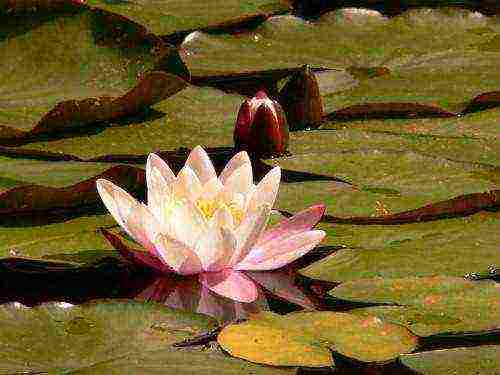
Water lily / water lily planting and care
Water lilies love fertile soil. Rotted compost is suitable as a substrate, to which coarse sand and garden soil are added. It is useful to add bone meal to the prepared mixture, which has a good effect on the development of water lilies. Large balls are rolled from the clay mixed with bone meal and placed under the roots of the water lilies when planting, or immersed in the ground in the next spring. This prevents the leaching of fertilizers and their rapid mineralization. When planting water lilies, it is necessary to lay the rhizomes on the ground with cord-like roots down. The roots are embedded in the substrate so that the plants do not float. The rhizomes themselves should protrude halfway from the soil, since deepening the growth point has a bad effect on the development of the plant. The depth of placement of the container depends on the type of water lily.
Care and planting advice
Planting water lilies in the ground at the bottom of the reservoir will be successful if it is at least 30 cm thick. Secure the rhizomes with wire or wooden hairpins, rubble and stones.
Water lily care in winter
In the middle zone, water lilies winter without hassle in large ponds at a depth of at least half a meter. Water lilies living in small bodies of water need to be pulled out of the water, cut off the leaves and flower stalks, then placed in a container in a frost-free place with low temperatures above zero.
Water lilies can be placed for the winter and in the pond, but the water must be drained, the leaves removed, the hollow must be covered with peat, covered with dry leaves, spruce branches. This method of caring for a water lily is the most laborious, because in the spring you will have to reanimate the entire pond. The pond may remain intact if, for the wintering of water lilies, a hole is dug, at least 0.5 m deep, the diameter of the hole should allow placing containers with plants for days. The pit is covered with soil and remains in this form until spring.
The best varieties of water lilies
| Сomanache. Water lily of Latour Marliaka selection, flower diameter 13 - 15 cm, planting depth 20 - 40 cm, coverage area 2.5 - 10.5 sq. M. |
| White 1000 Petals. Water lily of the selection of the nursery Perry Gardens, flower diameter 14 - 16 cm, planting depth 40 - 80 cm, coverage area 10.5 - 18 sq. M. |
| Almost Black. Water lily of the selection of Perry D. Slocum, flower diameter 12 - 15 cm, planting depth 40 - 60 cm, coverage area 10.5 - 18 sq. M. |
| Sulfurea Odorata. Water lily of Latour Marliak selection, flower diameter 10 cm, planting depth 15 - 50 cm, coverage area 2.5 - 10.5 sq. M. |
| Marliacea Rosea. Water lily of Latour Marliaka selection, flower diameter 12 - 15 cm, planting depth 40 - 90 cm, coverage area 10.5 - 18 sq. M. |
Rate the quality of the article. We want to be better for you:
